Colonel Thomas H. Monstery and the Use of the Quarterstaff
“It has struck me that a few words on the use of this two-handed staff may not be uninteresting at the present day…” –Thomas H. Monstery, 1878
New York City is typically not the first place that comes to mind when one mentions the word “quarterstaff.” For the average individual, unfamiliar with the history of western martial arts, the term is far more likely to conjure up images from “Robin Hood,” or of the medieval European peasantry. Yet, during the late nineteenth century, it was a Manhattan-based fencing master, Colonel Thomas Hoyer Monstery, who produced one of the few treatises on self-defense technique with the quarterstaff—the first such treatise to be published during the nineteenth century, and the only one to be published in America prior to the twentieth century. (1)
Before proceeding to Monstery’s treatise, however, it is worth taking a short look at the history of this weapon in Britain, Germany, and Scandinavia, and charting its use through the last few centuries—especially focusing on the period between 1740 and 1860, about which very little has been written during the modern era.
HISTORICAL BACKGROUND
The staff is an ancient weapon, perhaps nearly as old as civilization itself. During the late Middle Ages, treatises on fencing and armed combat often included sections on staff weapons. Later, during the sixteenth and seventeenth centuries, European authors (primarily from Britain and Germany) such as Andre Paurñfeyndt, Paulus Hector Mair, Antonius Rast, Joachim Meyer, George Silver, and Joseph Swetnam wrote detailed fencing treatises that included sections on long, two-handed staffs. Writing in 1615, British author Joseph Swetnam treated of a staff around seven and eight feet in length, which he referred to as the “quarterstaff.”
It was soon after this time that the weapon likely made its first arrival on American shores. Around the year 1680—after the British took possession of New York City from the Dutch—the City Council of New York ordered that constables and deputies be required to carry “a Halbert, halfe pike or Good Quarter staffe” while on duty. (2)
BRITAIN IN THE EIGHTEENTH CENTURY
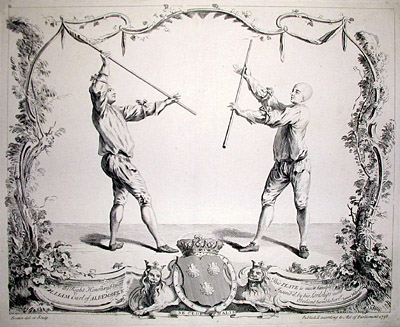
Plate from James Miller’s “Treatise on backsword, sword, buckler, sword and dagger, sword and great gauntlet, falchon, quarterstaff,” 1735
During the first half of the eighteenth century, the weapon was still commonly used throughout Great Britain, as evinced by the treatises of Sir William Hope, Zachary Wylde, Donald McBane, and James Miller. McBane, writing in 1728, noted its popularity among his fellow Scots and Britons:
“A Quarter-Staff is a weapon that has been made much use of, and is now much in request, for whoever is Master of the Staff, may defend himself against any one Man, with Back or small sword, as has often been Experienced, it is generally seven Foot long, and of Ash, if it can be had.” (3)
After the publication of James Miller’s book in 1735, no quarterstaff treatises (that we yet know of) seem to have been written until 1791, when Scottish fencing instructor Archibald MacGregor published his “Lecture of the Art of Defence,” which offers further insight into the use of the weapon:
“He may grip it by the middle and ward off a blow with either end of it; and thrust or cut which he pleases… There is a method also, of winding it like the figure eight, by catching it by the middle, and changing it from hand to hand, as you see me do. But indeed there is such a variety in it, that it would take up too much of your time to relate. It has often been known that people, who were dextrous at handling it, have forced their way through a croud, defending themselves, and knocking down numbers as they passed.”
MacGregor’s book is also notable in that it discusses how to apply quarterstaff technique to the bayonet. About this same time, at the end of the eighteenth century, the use of the quarterstaff in Britain seems to have been in general decline, as the Reverend John Wesley noted that “the noble game of quarter staff, likewise, is now exercised by very few.” (4)
However, a number of firsthand accounts indicate that British civilian and military men continued to practice, contest with, and provide instruction in the weapon. Examples of such individuals include Thomas Barret (an English instructor and prize fighter active in the 1750s); Sir Jonah Barrington (a member of the Irish Protestant Ascendancy who learned quarterstaff technique from his grandfather during the 1760s, and lived to pen his memoirs in 1827); the “famous quarter-staff master” Henkley (who gave private lessons to Lieutenant-General Henry Herbert, the 10th Earl of Pembroke during the 1780s); Christoper Towles (who instructed civilians in Coventry during the 1780s); James of Sandhurst; and soldier Harry Smith. (5, 6, 7, 8, 9) This last mentioned person (known by his nickname “the Squire”) was a native of Sussex, and the subject of an anecdote worth reprinting:
“[Harry Smith] was a complete sportsman of the Old School—skillful in the use of the cross and long bows, and at all athletic exercises—an adept at the single stick and quarter-staff, which last he would, till lately, turn with astonishing celerity. A well-known fact of his prowess in the last named exercise we subjoin: In 1779, a Sergeant of Elliott’s Light Horse being then at Chichester, and who was reputed one of the best swordsmen of the day, challenged his sword against the Squire’s staff, to draw the first blood; many are living who saw the encounter; when, at the expiration of four minutes, ‘the Squire’ gave his adversary the end of his staff in his forehead, which laid him flat on his back, and gained the victory. The staff, which is seven-feet ten-inches in length, is now preserved, and has thirteen cuts of the sword in it.” (10)
Harry Smith passed away in Chichester, in 1822, at the age of 84.
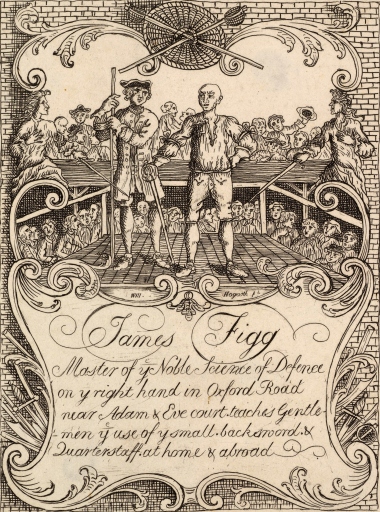
18th century trade card purporting to show James Figg offering instruction in the use of the quarterstaff. The authorship of this etching is uncertain and has been attributed to both William Hogarth and Joseph Sympson. Source: MET Museum, New York City.
THE NINETEENTH CENTURY
During the early nineteenth century, the quarterstaff was, according to one contemporary, yet “still seen in the hands of constables in some remote districts” of England, and still figured in “rustic” contests among the rural British. (11) In 1805, Cobbet’s Weekly Register extolled the virtues of “not only boxing, but wrestling, quarterstaff, singlestick” and “every exercise of the common people, that supposes the risk of life or limb, and, of course, tends to prepare them for deeds of bravery of a higher order.” (12) Several references by military men also attest to continued knowledge of quarterstaff technique. For instance, Lieutenant John Russell (Lieutenant and Adjutant of the Nottingham Staff), in his 1806 Series of Military Experiments of Attack and Defence, noted that
“Experience has proved that notwithstanding its weight, the modes of attack and defence with the bayonet may be reduced to a system similar to those of the broadsword and quarter staff; and that great advantage might be gained, in single contest, by a person previously instructed in such exercise.” (13)
Likewise, English naval officer and veteran Major John Cartwright (for seventeen years major of the Nottinghamshire Militia), writing in 1821, explained,
“Opposed to the horseman, the spearman’s point will be in the nose of the horse before the rider’s sabre can reach him; besides which, he, with his spear, will have against the sabre all the guards of the quarter staff, for defending every part of his person, and with his hands defended, which is not the case of him who handles the quarter staff, the long pike, or the musket.” (14)
Despite such continued knowledge of English staff technique, there can be no doubt that, during this period, people like Major Cartwright were in short supply. The following letter, published in the March 9th, 1828 issue of Bell’s Life in London and Sporting Chronicle, gives an idea of the state of English quarterstaff practice at that time:
To the Editor of Bell’s Life in London.
SIR— I would beg through the medium of your useful and entertaining Paper, which has so large a circulation in the sporting world, to express a wish I have long indulged, to witness the revival of the ancient, noble, and manly exercise of Quarter Staff, so successfully practiced by our hardy ancestors, and which is now nearly lost, being known only to a few individuals. Should I succeed in establishing a Society for its practice, I shall most cheerfully subscribe my might to its support, and contribute any assistance in my power to its formation; and beg to subscribe myself, Sir, yours, &c.
A TRUE-BORN ENGLISHMAN.
Although the author of this letter is unknown, it would seem that, after an interlude of several years, the writer got his wish. In 1835, Lieutenant Colonel Baron De Berenger noted that quarterstaff instruction was being offered at the British National Arena in Chelsea:
A fuller version of the above passage explains,
“Fencing, both with the Small and Broad Sword, and Self-protection with the Stick or Quarter-staff, are also taught, being branches of instruction too important to be overlooked. In the two preceding classes, the judicious application of even inferior power is demonstrated as means, where necessary, to overcome brutal and superior strength, and ferocious attacks. A Fencing Saloon, adjoining the Gymnasium, is devoted to such ends.”
These techniques, according to the Colonel, were “at present either taught by skillful professors, or practised under the guidance of experienced persons.” (15) At about the same time, the English jurist and legal reformer Jeremy Bentham wrote his “Constitutional Code,” in which he included a section on “Defensive Force,” that had been read and approved by three colonels in the British army. Here it was noted that, for the “active occupation” of the men, instruments should be provided so that “the exercise of fencing, broadsword, quarter-staff…and other pastimes partaking of, or approaching to, the nature of military exercises, may be practised.”(16)
Beginning in the early 1850s, the quarterstaff became featured in various Grand Assaults-of-Arms and military tournaments throughout Great Britain (see advertisement below).
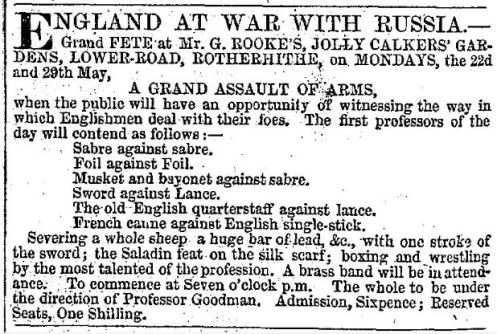
1854 announcement for a Grand Assault of Arms involving the “old English quarterstaff” under the direction of a “Professor Goodman,” published in the Era, on May 21.
Later, in 1862, Robert Kemp Philp stated that, “the inhabitants of some of the northwestern counties of England are still remarkably expert at the quarter-staff, and take great pleasure in the play of it.” And that same year, Professor John C. Gregory, an instructor at the Leeds Gymnastic Club, began holding a number of Grand Assaults-of-Arms throughout Britain (at venues such as Victoria Hall in Leeds, and the Crystal Palace in London), at which figured “rustic sports,” including contests and demonstrations of the “Old English Quarterstaff” (see image below). Some of these contests, it was noted, were held before the Queen of England.
In 1865, Major-General Sir Robert Napier wrote a letter to the Duke of Cambridge, noting that, “our [military] men…furnish the best boxers, wrestlers, and quarter-staff players in the world.” (17) During the mid-1860s, the weapon experienced a surge in popularity, and was featured in numerous Grand Assaults and military tournaments—a trend that would last until the turn of the century. (18) During this same period of popularity, multiple authors were in agreement that the quarterstaff traditions were essentially being rescued from the brink of extinction–verifying the sentiment expressed in the 1828 Bell’s Life letter. For instance, in his 1883 text, Thomas McCarthy, after writing of his own “sixteen years’ experience” with the quarterstaff, lamented that the weapon had “become almost obsolete.” And in its March 5th, 1897 issue, the Navy & Army Illustrated magazine noted that “it is much to be regretted that [the quarterstaff] should have been allowed to drop into almost entire disuse.”
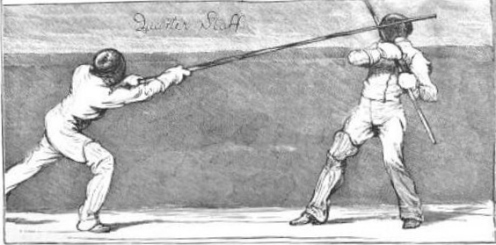
Above: A quarterstaff assault at the London Athletic Club, 1874 (from the Graphic, Vol. 10). During the 1880s and 1890s, British treatises on staff technique would be published by practitioners Thomas McCarthy, R.G. Allanson-Winn, and C. Phillips-Wolley.
LATE GERMANIC AND SCANDINAVIAN TRADITIONS
The Germanic equivalent of the quarterstaff (the Lange Stange or Halbe Stange), figured prominently in a number of Renaissance-era treatises. Later, during the eighteenth century, German quarterstaff fencers were pictured in an engraving of a late Fechtschule (fencing school) that notably depicts the use of numerous “antiquated” weapons, including the quarterstaff:
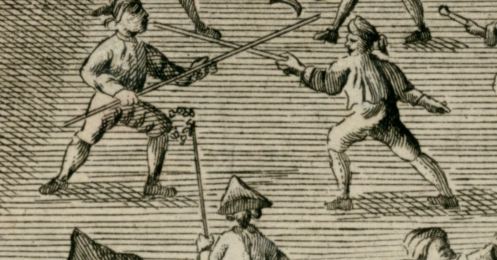
This early 18th-century copperplate depicts a late Fechtschule of the Marxbrüder and Federfechter. Source: Christoph Amberger’s site; original at https://fencingclassics.wordpress.com/2010/01/22/fechtschule-germany-18th-ct/
According to the writings of noted duelist and fencing master, Colonel Thomas H. Monstery, a tradition of quarterstaff fencing survived into the nineteenth century in his native Denmark, as well as in neighboring regions of northern Germany, where it was taught to members of the peasant militia, primarily for use in riot control. Monstery states that the staff exercise was still being taught in those areas, or were when he was a “youth.” Given Monstery’s date of birth, this would have been during the 1830s or early 1840s.
According to Monstery, a line of men, so armed “with big staves,” could clear a path through any mob, provided that the latter did not have firearms. (19)
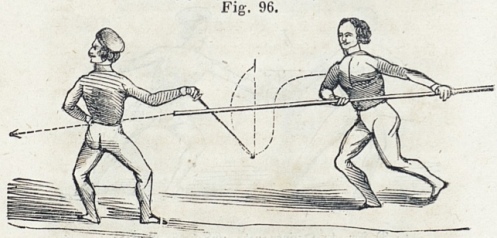
Above: Defense against staff weapons in the system of Pehr Henrik Ling (founder of the Central Institute of Physical Culture in Stockholm), illustrated and published in the 1850s by a disciple of Ling’s system. Monstery trained at the Central Institute, where, according to his biography, he was certified as a Master of Arms. Image from the author’s collection.
It is, perhaps, here worth noting as an aside that staff weapons, generally speaking, were still used by various European militaries during this period. Likewise, weapons such as the quarterstaff, the spear (used by militias), and the pike (still utilized in naval boarding actions) were part of the curricula at certain Germanic and Scandinavian military academies. The special Austrian Military Teachers’ School at Wiener Neustadt, for instance, one of the Imperial Institutions for Military Education, maintained a curriculum that included “Staff, Rapier, Sword and Bayonet Fencing.” This school was charged with the task of training and providing “instructors in gymnastics and fencing for all the military schools and for the troops.” (20) Likewise, the Central Institute of Physical Culture (Kungliga Gymnastiska Centralinstitutet) in Stockholm, founded by the celebrated Dr. Pehr Henrik Ling (himself a fencing master), offered instruction in the use of the pike and spear. (21) The Royal Military Gymnastic Institute (Kongelige Militaire Gymnastiske Institut) at Copenhagen, directed by Franz Nachtegall, also included the quarterstaff as part of its fencing curriculum.
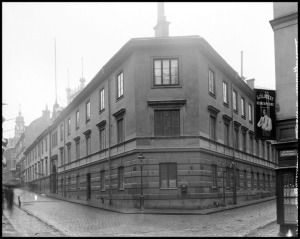
Ling’s Central Institute in Stockholm, where Monstery trained. Source: http://www.stockholmskallan.se
MONSTERY’S QUARTERSTAFF TREATISE
It was at this last-mentioned institution, the Royal Military Gymnastic Institute at Copenhagen, where Col. Monstery learned to handle the “sword, musket and bayonet, rapier, cudgel and quarterstaff” during the 1840s. (22) Monstery also continued his studies at Ling’s Central Institute of Physical Culture at Stockholm, which (as previously noted) included the use of other staff weapons in its curriculum.
After traveling the world, and taking part in numerous duels, battles, and revolutions, Monstery immigrated to America, where he opened several fencing academies, and continued to teach and demonstrate older methods of fence throughout the United States, as can be seen in many accounts of his fencing events. (23) In a well-publicized Grand Assault-of-Arms held in New York City in 1876, at the Lyceum Theatre on Fourteenth Street, Monstery included contests and demonstrations of the quarterstaff, as well as other older weapons such as the rapier and smallsword. According to one of the many newspaper announcements for this event,
“The weapons used on that occasion will include foil, broadsword, rapier, bayonet, lance and Bowie-knife, the English single stick and the double quarter staff, which was formerly the great weapon in use among the athletic peasants of the west of England.” (24)
In 1877 and 1878, Monstery published his treatise on the art and science of self-defense, which, after covering boxing, kicking, grappling, and cane defense, included two chapters on the use of the quarterstaff. In his first such chapter, Monstery notes that, at the time of writing, the two-handed staff was still being carried by the inhabitants of the mountainous regions in Europe, and
“as Americans are always traveling in these countries nowadays, and always liable to get into trouble with the people, it may be useful to know how to handle a long staff as well as a short one.”
Monstery thus declares,
“It has struck me that a few words on the use of this two-handed staff may not be uninteresting at the present day…”
In the pages of his treatise, Monstery describes his own method as “a little different” than the old British style. However, he presents his illustrated figures in medieval costume, in acknowledgment of the fact that “the scientific use of the staff dates from those times.”
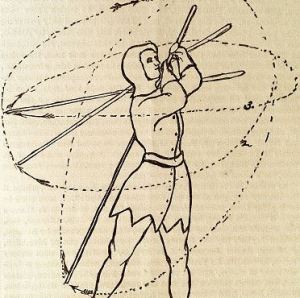
Above: One of several illustrations from the quarterstaff section of Monstery’s treatise, showing an exercise to give “ease and suppleness.” Photograph of original from the author’s collection.
In his lessons, Monstery instructs the reader to use a staff as high as one’s head. His technique includes a variety of guards, parries, “blows,” feints, and includes both “cutting” attacks as well as thrusts.
There is also a distinctive pedagogic quality to Monstery’s lessons that is missing from other quarterstaff treatises. For instance, Monstery includes footwork drills in his chapter on the staff, as well as exercises that give the user of the quarter-staff “the same ease and suppleness which the moulinets give with the single-handed cane or single stick.” (25)
All of its uniqueness aside, Monstery’s work is special in that it is the first quarterstaff treatise published during the nineteenth century, and the only such treatise published in America prior to the twentieth century. (26)
POSTSCRIPT
After his Grand Assault-of-Arms at the Lyceum Theatre, there is no further record of Monstery publicly exhibiting or demonstrating the use of the staff, and the old fencing master eventually passed away in 1901. However, in 1875, Monstery had posted the following advertisement in the New York Herald:
“WANTED—A MASTER OF THE ART OF FENCING, or one who is desirous of learning the profession, to become an assistant at Colonel MONSTERY’S Fencing and Boxing Academy, 619 6th av.” (27)
The next year, in 1876, the Army and Navy Journal noted that Monstery had acquired an assistant, one Captain James McGregor of London. (28) McGregor would go on to issue and accept a number of challenges in New York State, at least two of which included the quarterstaff. Notably, McGregor had taken part in Monstery’s Grand Assault at the Lyceum, in which quarterstaff fencing had been exhibited. More than two decades later, as reported by the Buffalo Courier-Record, McGregor would accept a challenge from the famed champion Duncan Ross. McGregor stipulated that it be a contest of “mixed weapons,” which would include “quarterstaff.” (29)
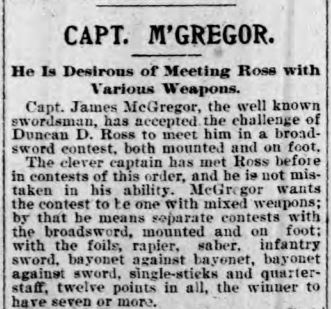
Above: Monstery’s former assistant, Captain James McGregor, accepts Ross’s challenge in the Buffalo Courier-Record, 1897.
In 1899, McGregor issued another challenge to Maestro Generoso Pavese, who had claimed the title of champion, and who had defeated a number of fencers in several widely-publicized contests. Again, McGregor’s challenge included the quarterstaff:
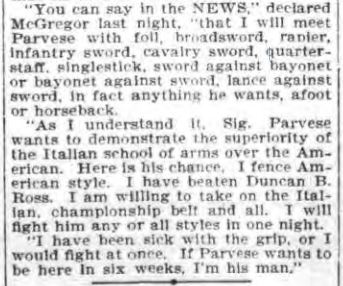
Above: Another challenge from McGregor, to Pavese, published in the Buffalo Evening News, March 5, 1899.
McGregor’s comment (seen in the image above) that he fenced “American style” is an interesting one, given his British origins. Whether McGregor was using Monstery’s quarterstaff technique in these contests, or a system that he learned in his own country, is a matter of speculation. Whatever the case, the report is evidence that as late as 1899, quarterstaff fencing was still alive and well in New York State.
Colonel Thomas H. Monstery‘s martial wisdom survives in his treatise on Boxing, Kicking, Grappling, and Fencing with the Cane and Quarterstaff, which was recently published by North Atlantic Books in book form for the first time. This volume contains a new, detailed biography of Monstery, and includes additional writings by the Colonel.
Additional articles about Thomas H. Monstery can be found here as well.
NOTES:
- Thomas Hoyer Monstery, Self-Defense for Gentlemen and Ladies (Berkeley: North Atlantic Books, 2015).
- Minutes of the Common Council of the City of New York, 1675-1776 (New York: Dodd, Mead and Company, 1905), Vol. 1, 94.
- Donald McBane, The Expert Sword-Man’s Companion, Or the True Art of Self-Defence. With An Account of the Author’s Life, and his Transactions during the Wars with France. To which is Annexed, The Art of Gunnerie (Glasgow: Printed by James Duncan, and are to be sold at his Shop in the Salt-Market, 1728), 66-67.
- Rev. John Wesley, Sermons on Several Occasions (New York: Carlton & Phillips, 1855), Vol. II, 271.
- John Harland, Collectanea Relating to Manchester and Its Neighborhood, at Various Periods (Printed for the Chetham Society, 1847), Vol. II, 91-92. Following is the account of Barret: “When I was a boy about eight years old, a noted prize fighter came to Manchester, by name Thomas Barret, an old man, with his face cut and scarred all over, so that for the most part he went by the name of ‘Old Chopping-block.’ He taught the science of defence (or what I should think was sometimes offence), in a large room at the Old Boar’s Head, Hyde’s Cross. While in town he articled with a stranger to show their feats of arms in public, in a yard near Salford Chapel; at which place I attended to see the exhibition, which was performed upon a stage in manner following: First, the champions entered the lists in their shirts, and bare-headed, with each a quarter-staff, about two yards long and as thick as the handle of a pikel. These they brandished and whirled about with surprising dexterity; not forgetting every now and then to reach each other a lusty souse upon the sides, shoulders, or head, which was no ways displeasing to the spectators…In some while after Thomas Barret went to Ireland, and there followed the same business, and in a combat received a cut in his belly, which let his bowels out and ended his days.”
- Sir Jonah Barrington, Personal Sketches of His Own Times (London: George Routledge and Sons, 1869), 33. Barrington, a member of the Irish Protestant Ascendancy, recounted in 1827 that his grandfather “had taught me the broadsword exercise with his cane, how to snap a pistol, and shoot with the bow and arrow; and had bespoken a little quarter-staff to perfect me in that favourite exercise of his youth, by which he had been enabled to knock a gentleman’s brains out for a wager, on the ridge of Maryborough, in company with the grandfather of the present Judge Arthur Moore, of the Common Pleas of Ireland. It is a whimsical gratification to me to think that I do not at this moment forget much of the said instruction which I received either from Michael Lodge the Matross, or from Colonel Jonah Barrington—though after a lapse of nearly sixty years!”
- Henry Angelo, The Reminiscences of Henry Angelo, with Memoirs of his Late Father and Friends, Including Numerous Original Anecdotes and Curious Traits of the Most Celebrated Characters that Have Flourished During the Last Eighty Years (London: Henry Colburn and Richard Bentley, 1830), Vol. II., 426-427. According to Angelo, “this Robin Hood…had often given his lordship a good thrashing.”
- In 1788, Christopher Towles, of High Street, in Coventry, offered instruction in skills “of the greatest use in the Army and Navy,” such as “the Single-Stick, Quarter-Staff, Broad-Sword, Small-Sword, Wrestling, Boxing…” Advertisement (originally from 1788) reprinted in the Northampton Mercury, Oct. 22, 1842.
- Peter Hampson Ditchfield, Old English Sports, Pastimes and Customs (Methuen & Co., 1891), 38, 54. Ditchfield recounts, “The game of quarter-staff is an old pastime which was a great favourite among the rustics of Berkshire. The quarter-staff is a tough piece of wood about eight feet long, which the player grasped in the middle with one hand, while with the other he kept a loose hold midway between the middle and one end…An old parishioner of mine, James of Sandhurst, was once the hero of quarter-staff in the early part of the [nineteenth] century.”
- The Gentleman’s Magazine (Westminster: John Nichols and Son, 1822), 286.
- Cambrian and Caledonia Quarterly Magazine and Celtic Repertory, Volume 5 (London: H. Hughes, 1833), 61. See also Ditchfield, 38, 54.
- Cobbett’s Weekly Register, August 10, 1805.
- Lt. John Russel, A Series of Military Experiments in Attack and Defence, Made in Hyde Park in 1802, Under the Sanction of His Royal Highness the Commander in Chief (London: T. Egerton, 1806), 210.
- Nestor Lonchophoros [Major John Cartwright], Military hints to the Greeks (London: Richard and Arthur Taylor, 1821), 5.
- Lt. Col. Baron De Berenger, Helps and Hints how to Protect Life and Property (London: T. Hurst, 1835), 255.
- John Bowring, The Works of Jeremy Bentham (Edinburgh: William Tait, 1843), Vol. IX, 342.
- Colonel Willoughby Verner, The Military Life of H.R.H. George, Duke of Cambridge (London: John Murray, 1905), Vol I, 332.
- The resurgence in the 1860s can be documented by a number of accounts in the British media; see, for instance, Leeds Mercury, January 11, 1866; London City Press, March 31, 1866; Sporting Life, March 31, 1866; Brighton Gazette, Dec. 20, 1866; Chelmsford Chronicle, April 12, 1867; Aldershot Military Gazette, June 13, 1868; for the 1870s onward, see Tony Wolf, “‘A Grand Assault-at-Arms’: Tournaments and Combative Exhibitions in Victorian England” in The Journal of Manly Arts (August, 2001).
- Monstery, Self-Defense for Gentlemen and Ladies, 165.
- Report of the Commissioners Appointed to Consider the Best Mode of Re-organizing the System for Training Officers for the Scientific Corps (London: Eyre and Spottiswoode, 1857), 215.
- Monstery, Self-Defense for Gentlemen and Ladies, 4.
- Ibid.
- Ibid, 28-31.
- Ben Miller, A Grand Assault-of-Arms in Old New York, Directed by Colonel Monstery, 2015.
- Monstery, Self-Defense for Gentlemen and Ladies, 163-174.
- Although the Chicago-based instructor Giuseppe Riboni published a book in 1862 entitled “Broadsword and Quarter-staff,” the weapon referred to as the “quarter-staff” therein is actually the Italian bastone a dui mani. See Giuseppe Riboni, Broadsword and quarter-staff without a master: broadsword fencing and stick or quarter-staff play, after the latest European practice adopted in the military schools of France and Italy, and the United States (Chicago: E. B. Myers: 1862).
- New York Herald, July 22, 1875.
- Army and Navy Journal, April 22, 1876.
- Buffalo Courier-Record, October 15, 1897.
Text of this article © 2015 by Ben Miller.
Trackbacks & Pingbacks
- A Bare-Knuckle Fight at Colonel Monstery’s | Out of This Century
- Colonel Thomas Monstery, and the Training of Jaguarina, America’s Champion Swordswoman | Martial Arts New York
- The Victorian Gentleman’s Self-Defense Toolkit | Out of This Century
- The Monstery-Senac Fencing Contest of 1876 | Out of This Century
- The Monstery-Senac Fencing Contest of 1876 | Ακαδημία Ιστορικών Ευρωπαϊκών Πολεμικών Τεχνών
- Colonel Thomas H. Monstery and the Use of the Quarterstaff | Paleotool's Weblog
- A History of Cane Self-Defense in America: 1798-1930 | Martial Arts New York

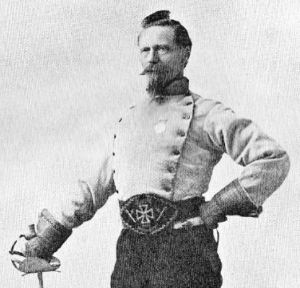
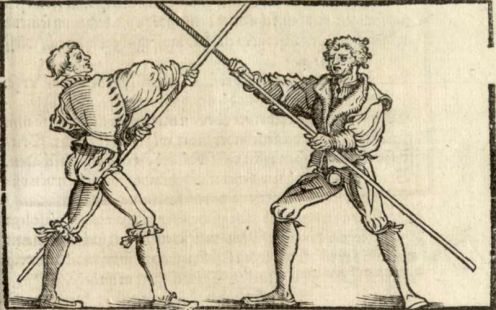
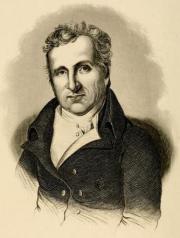
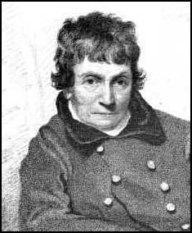

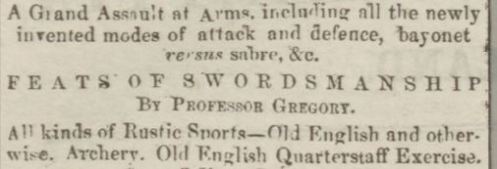
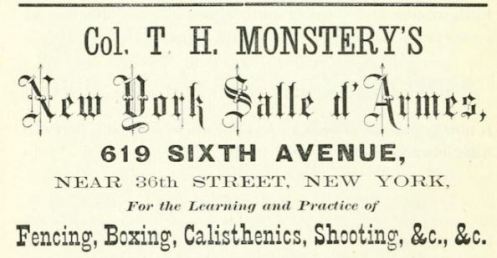
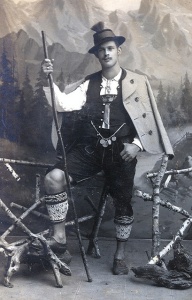
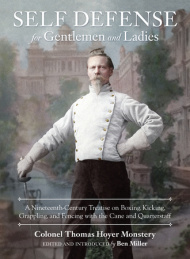

Reblogged this on Out of This Century.
LikeLike
Reblogged this on Ακαδημία Ιστορικών Ευρωπαϊκών Πολεμικών Τεχνών.
LikeLike